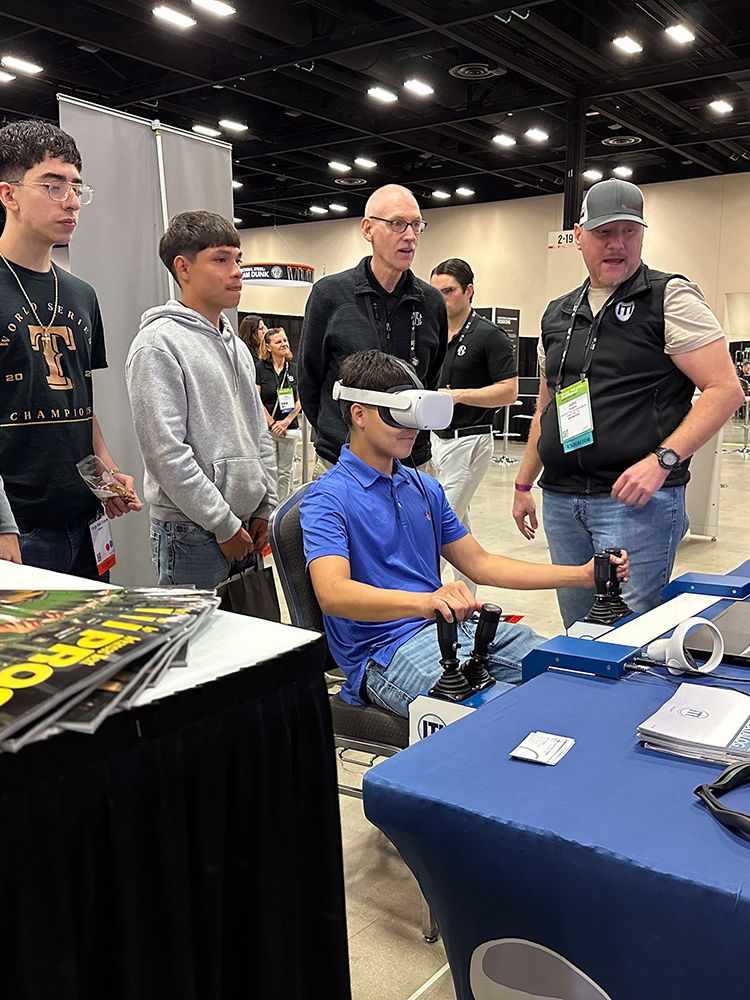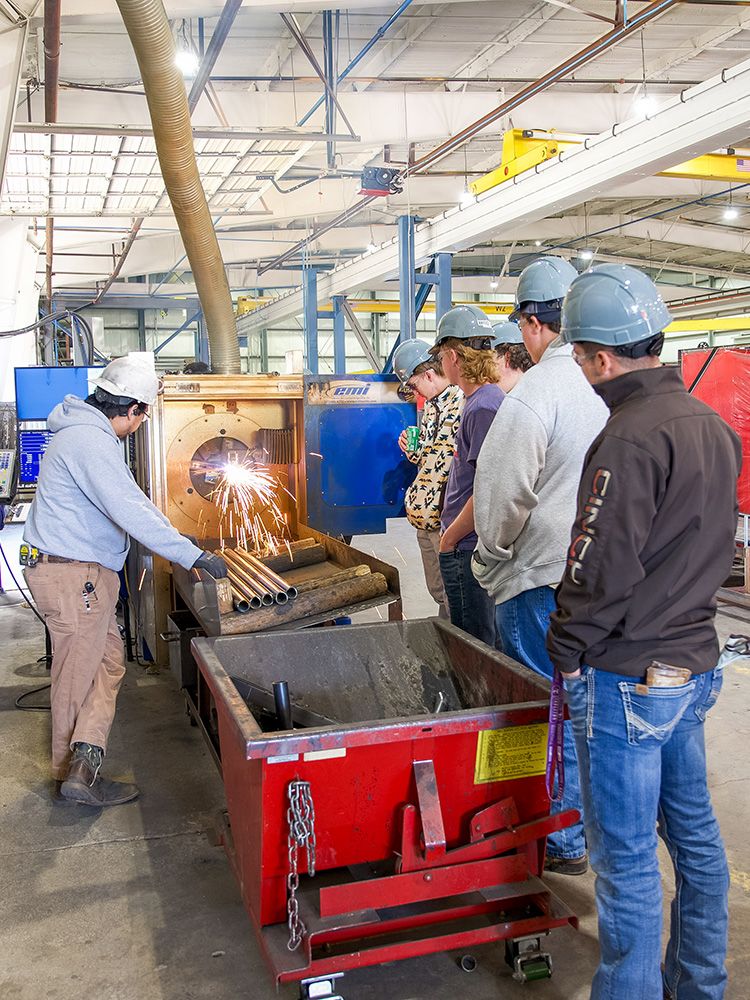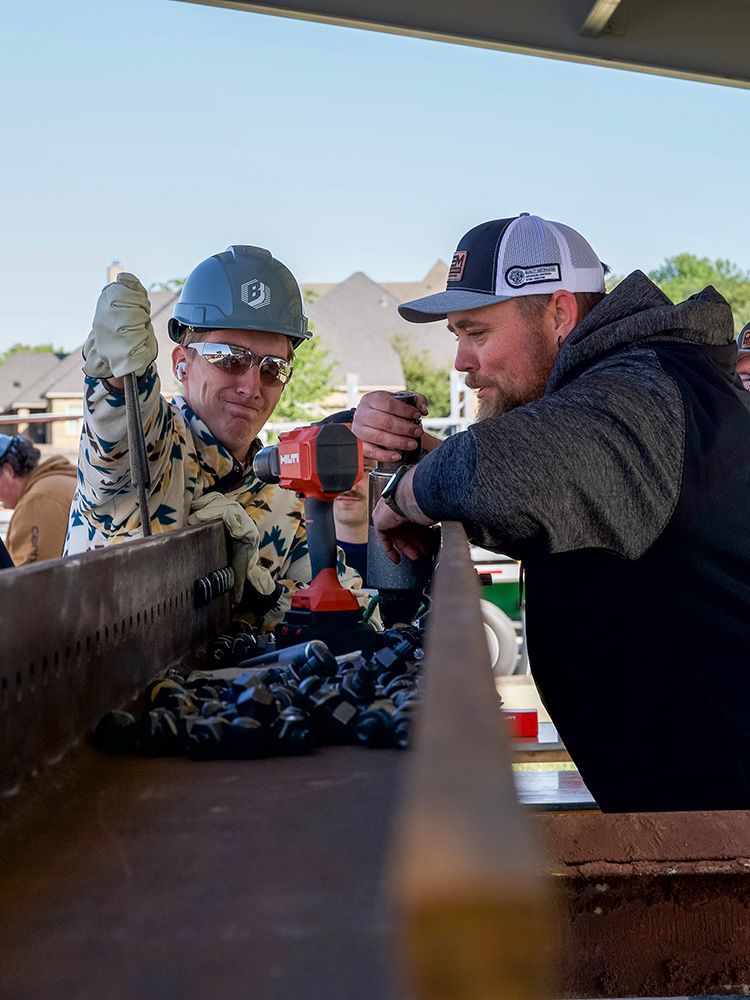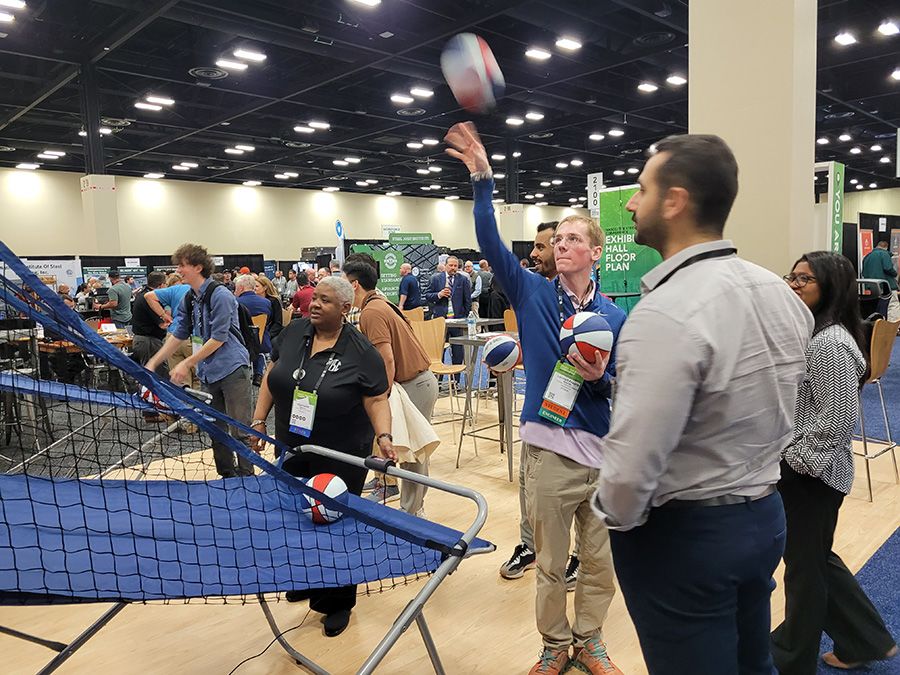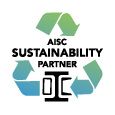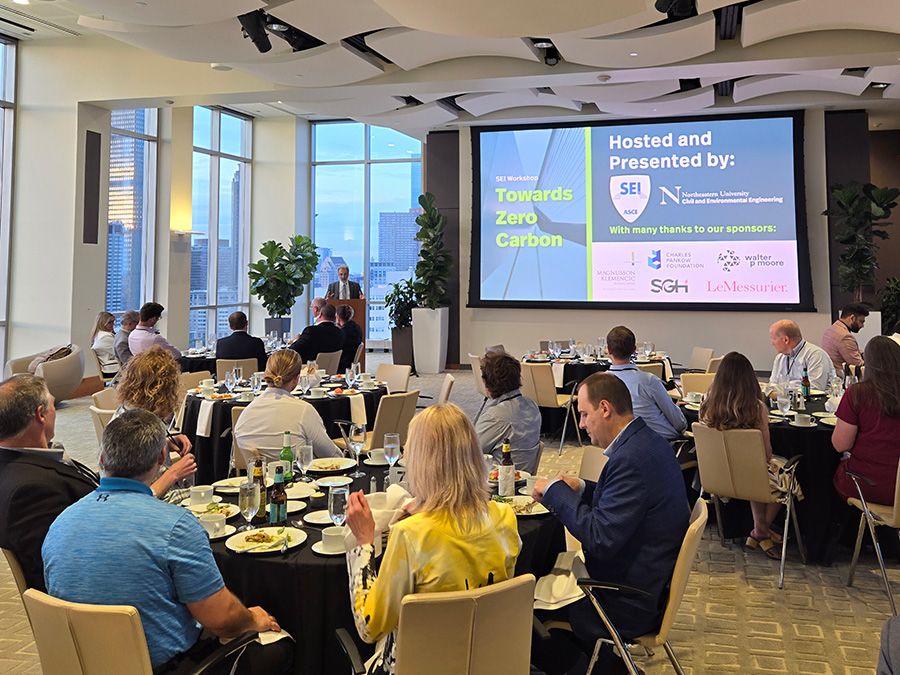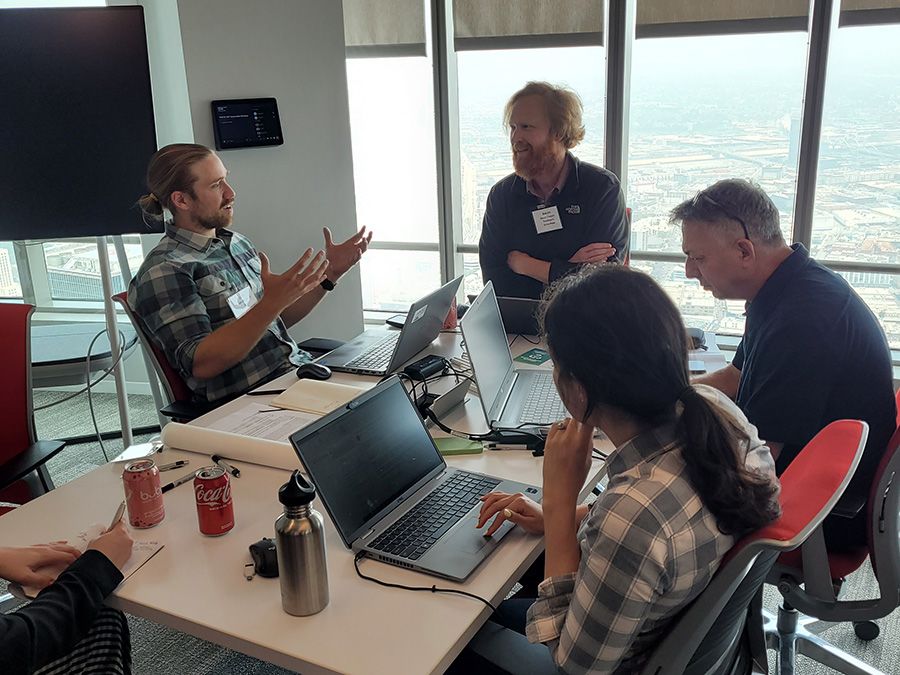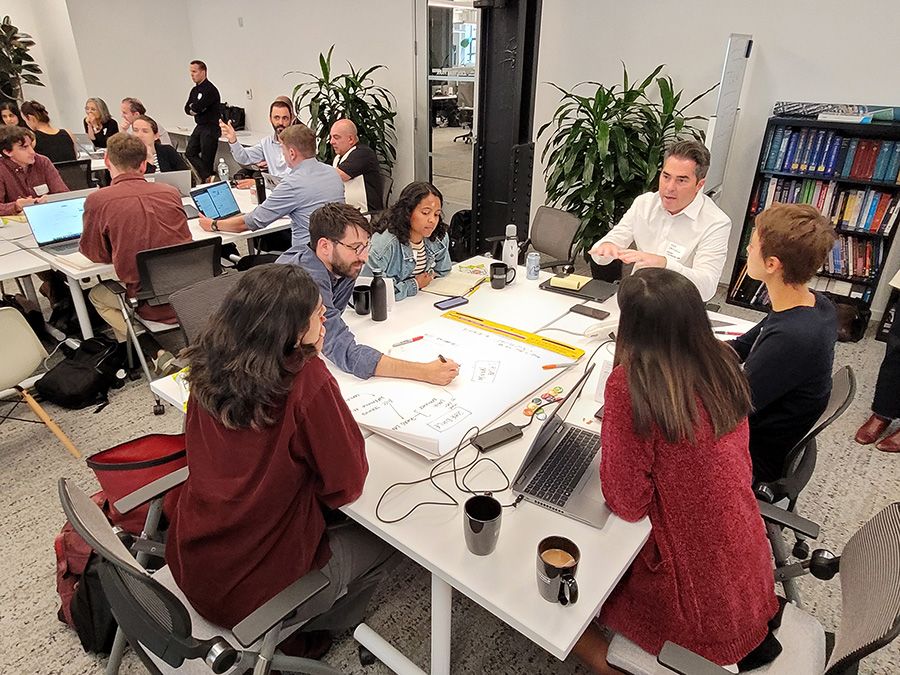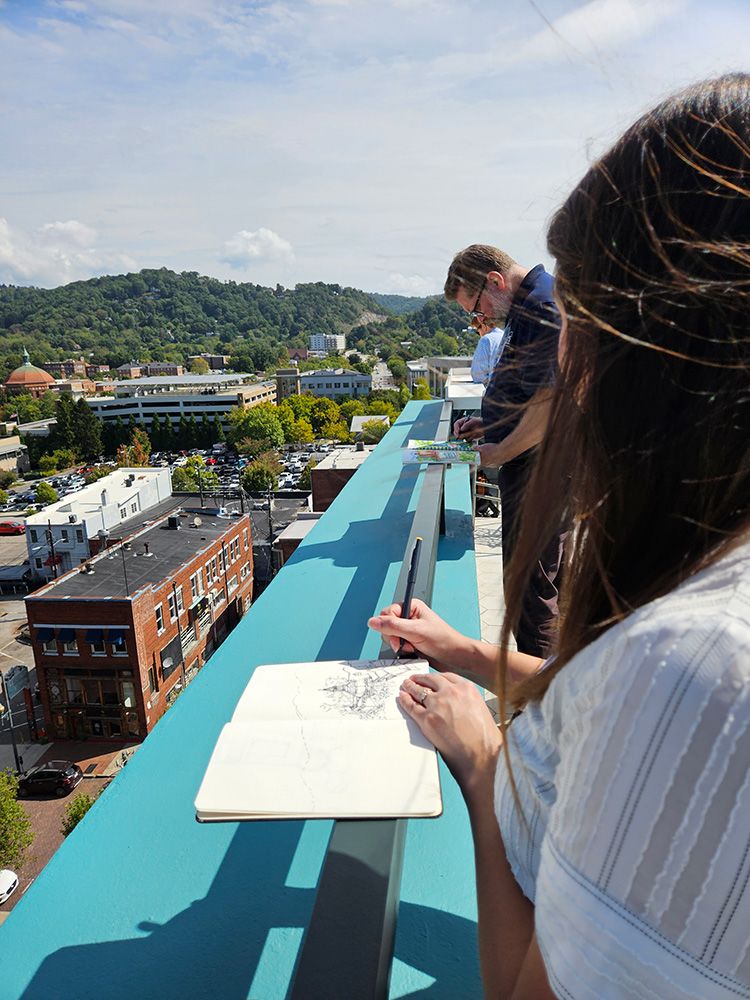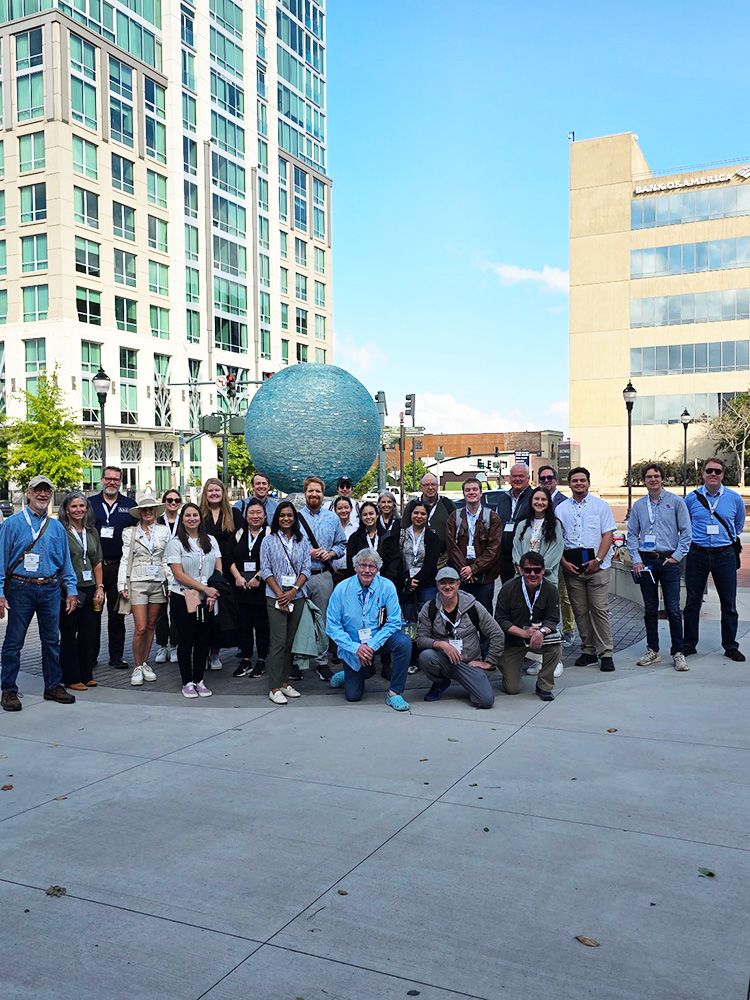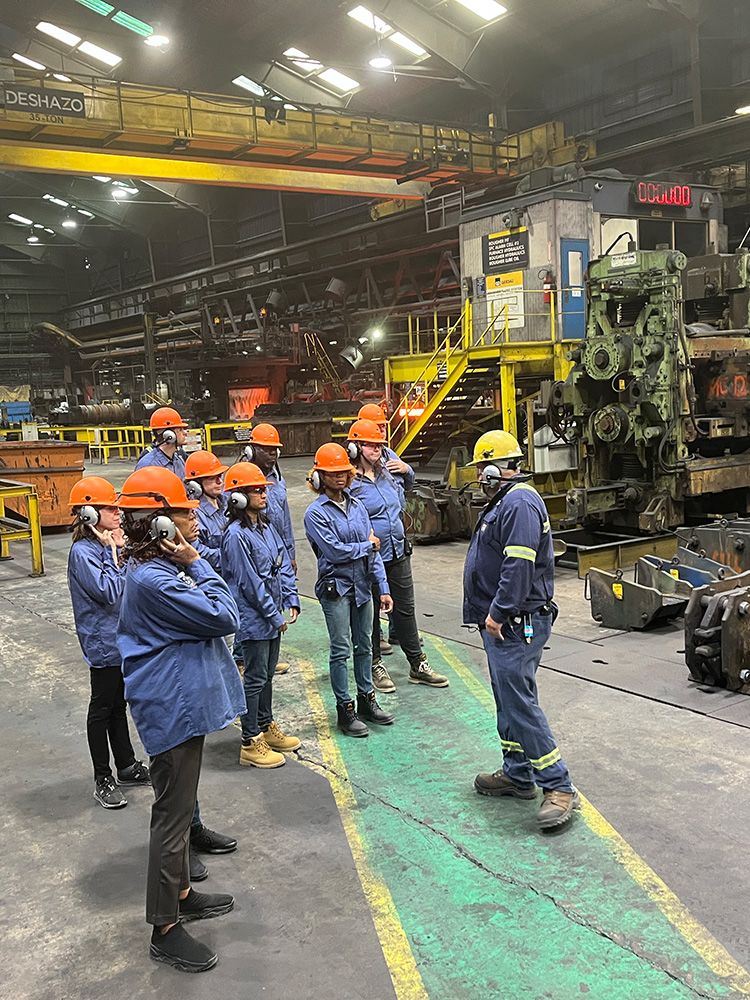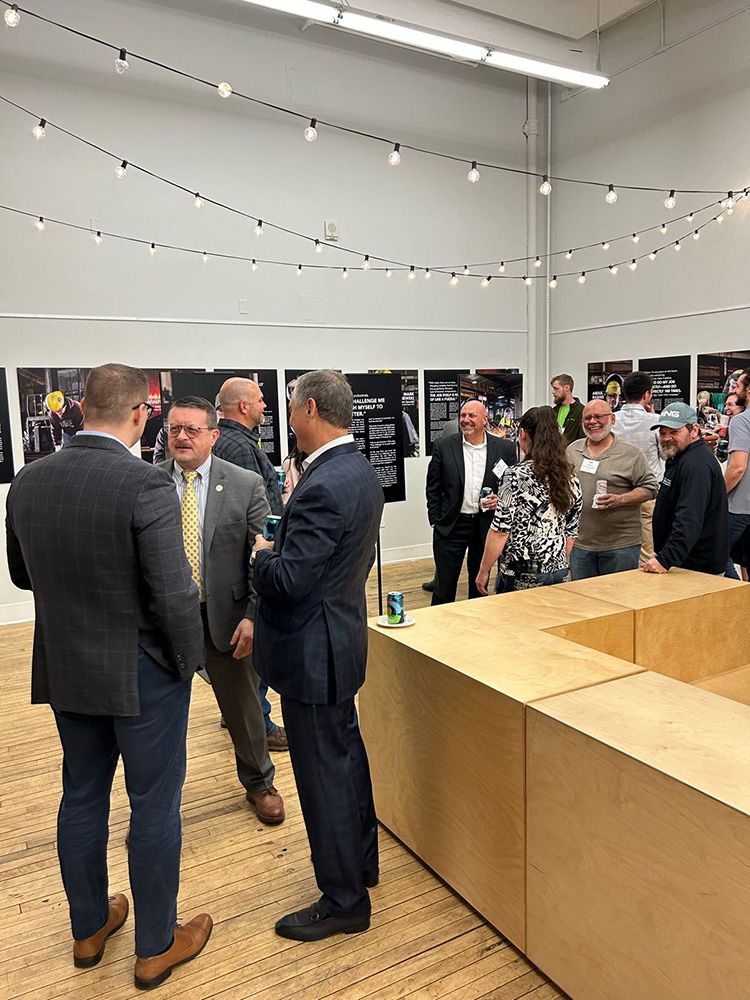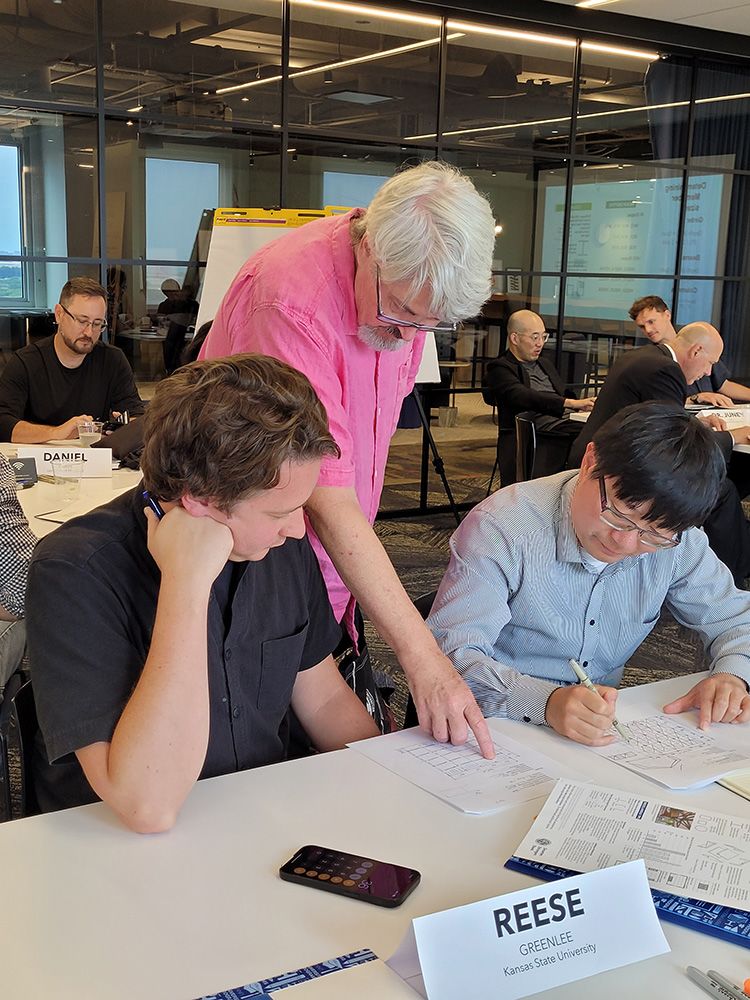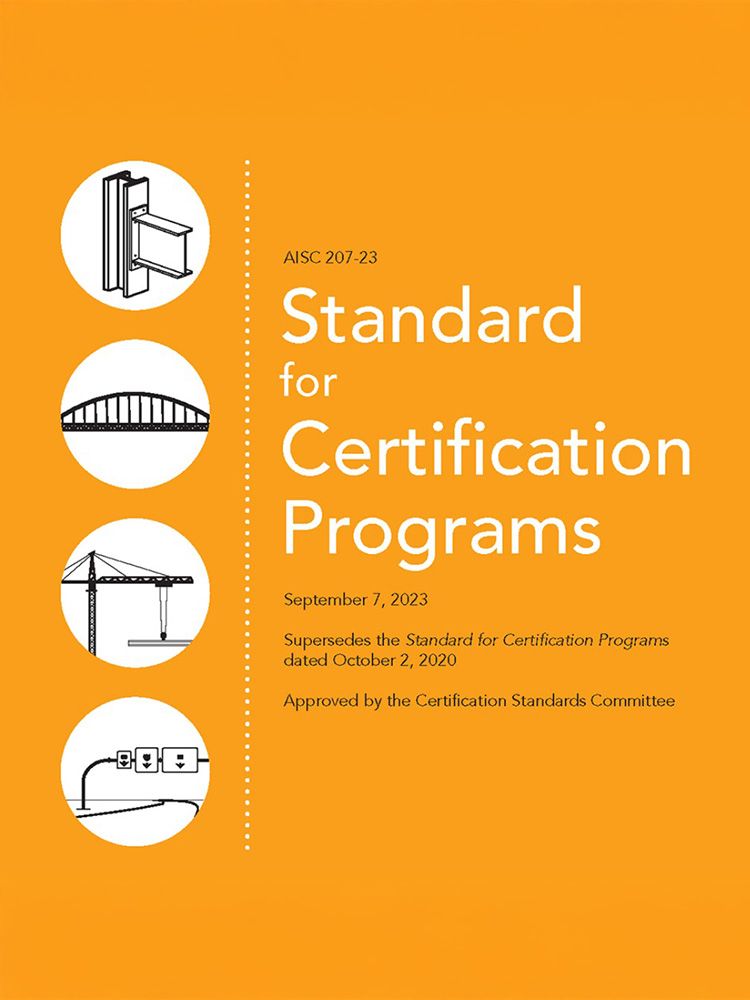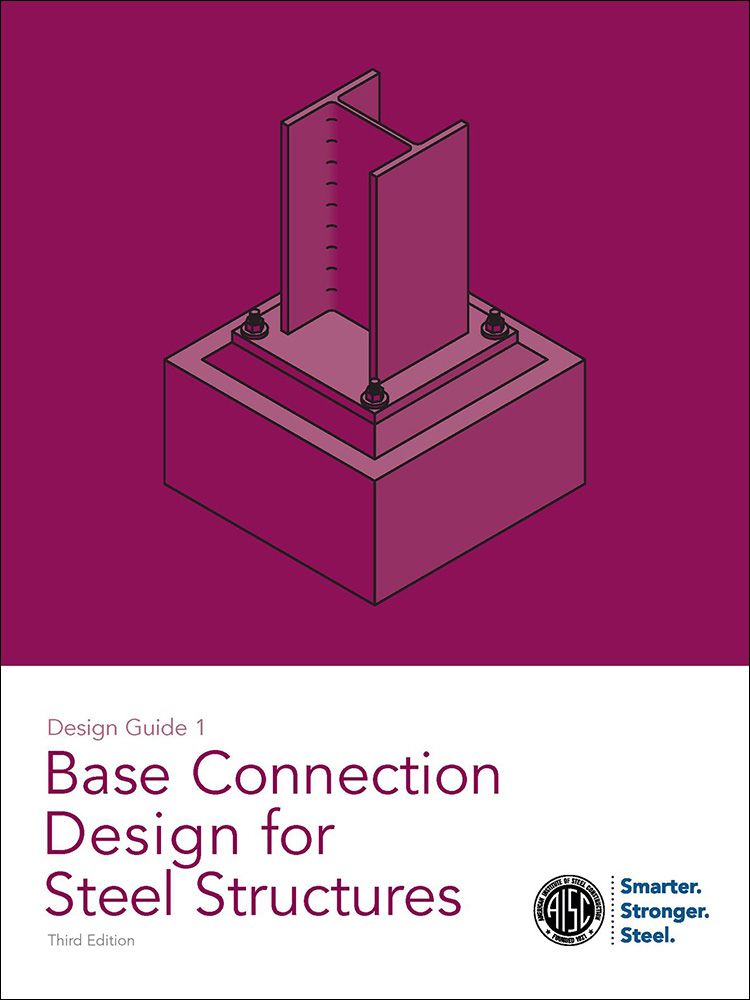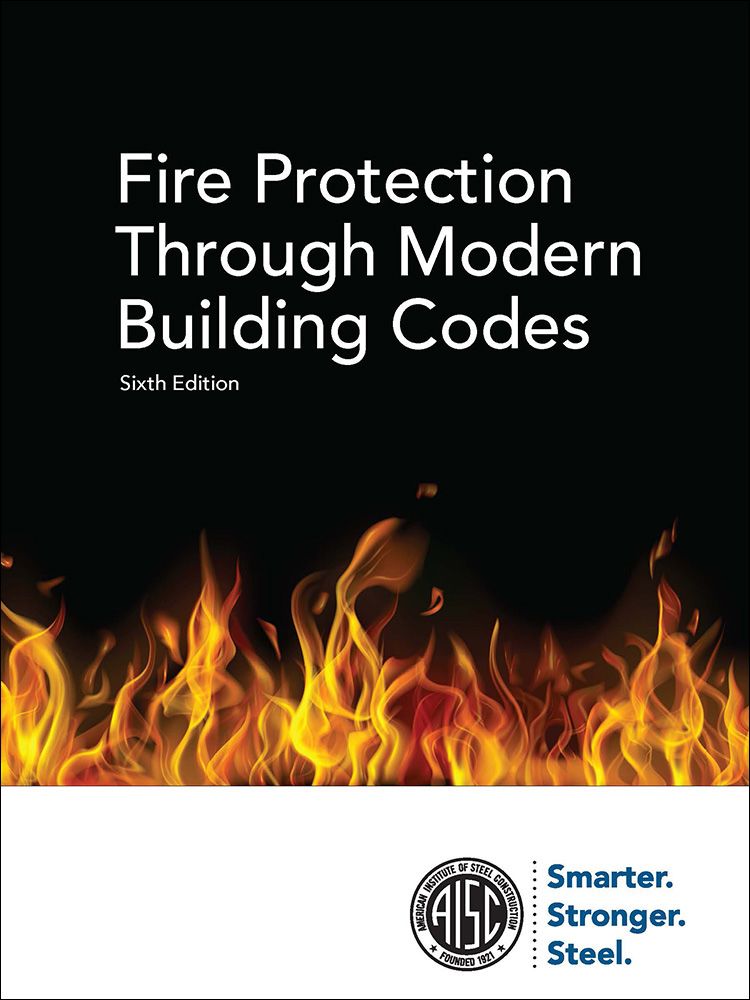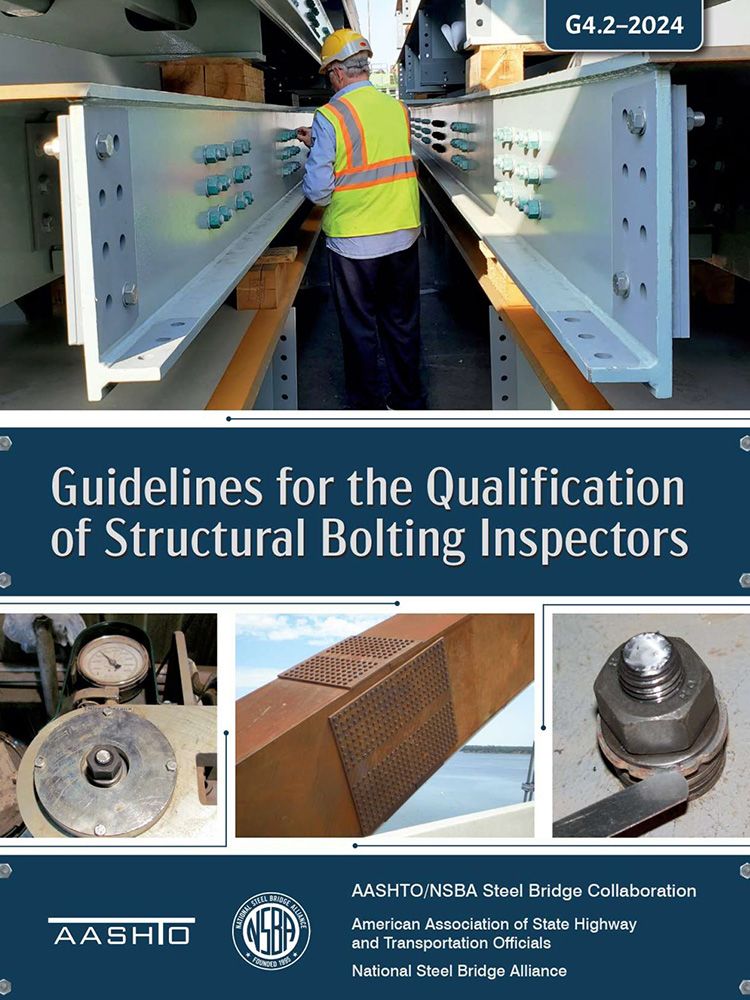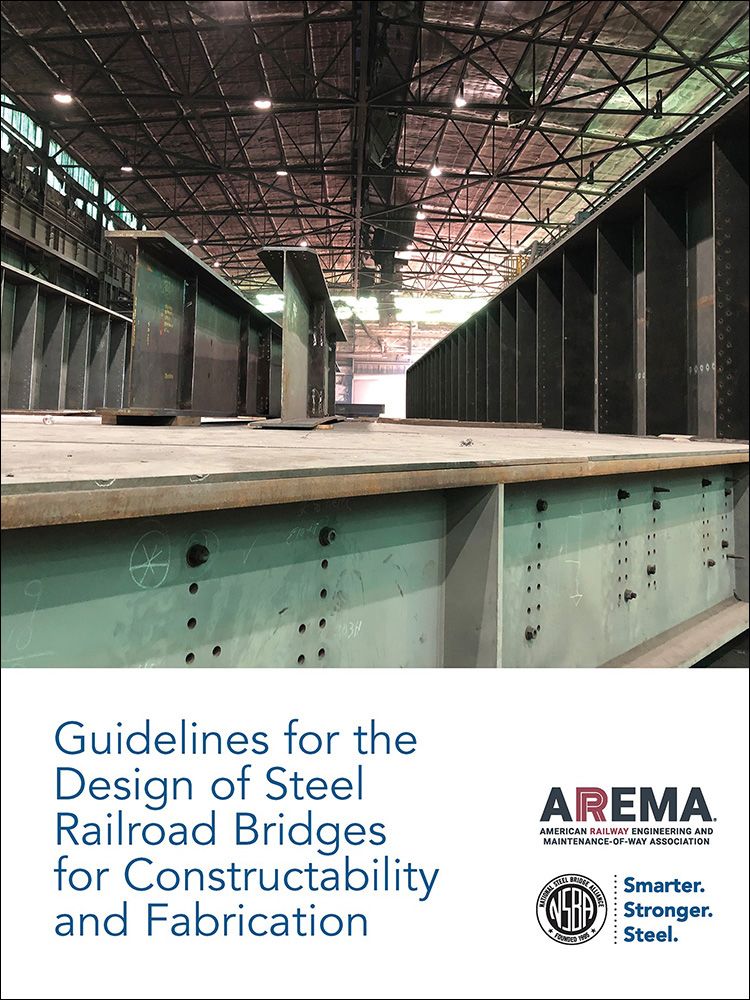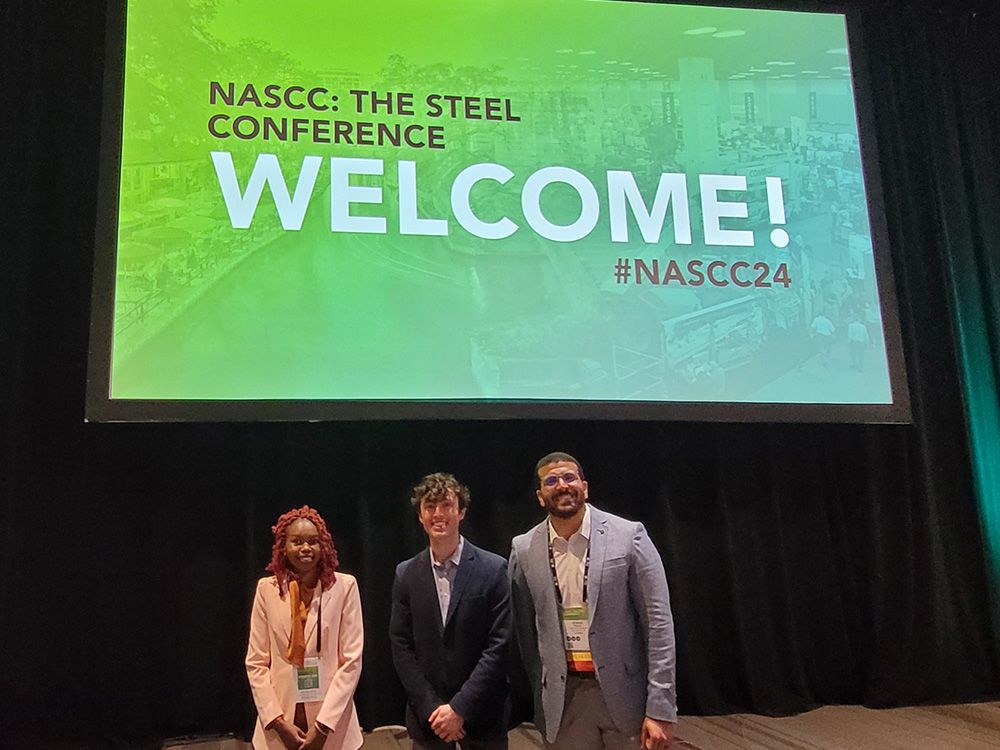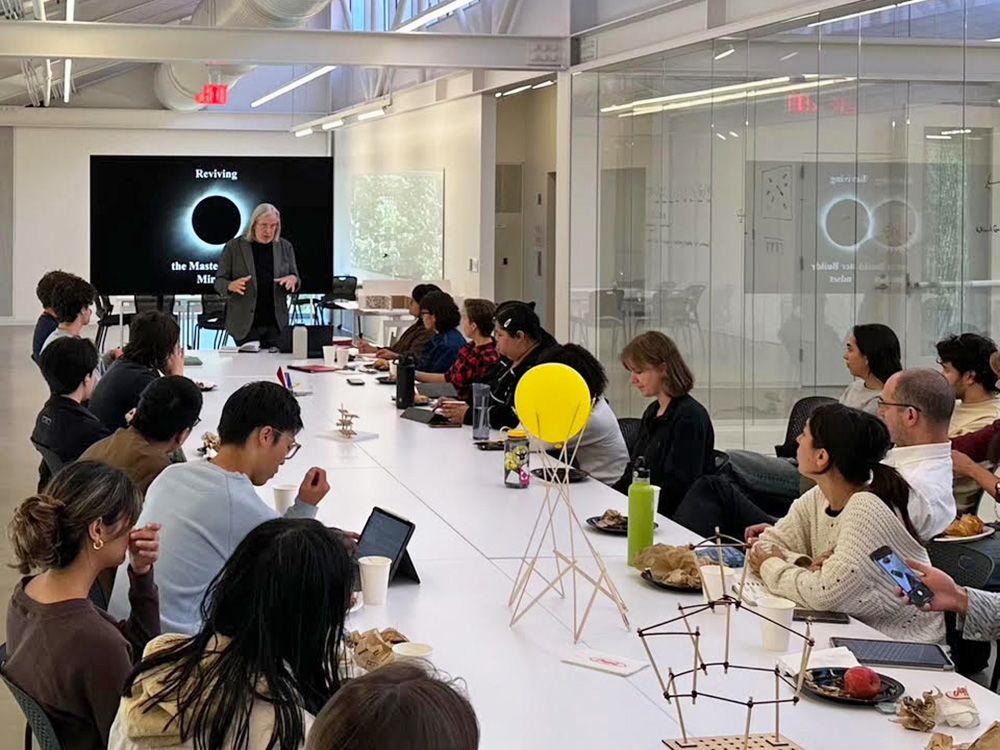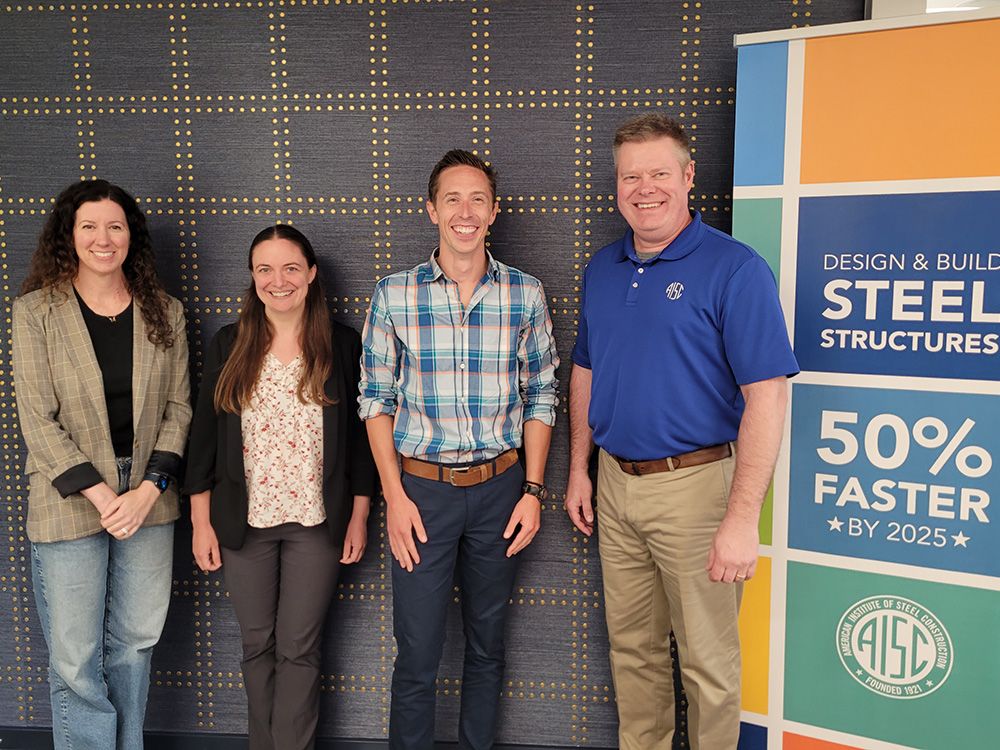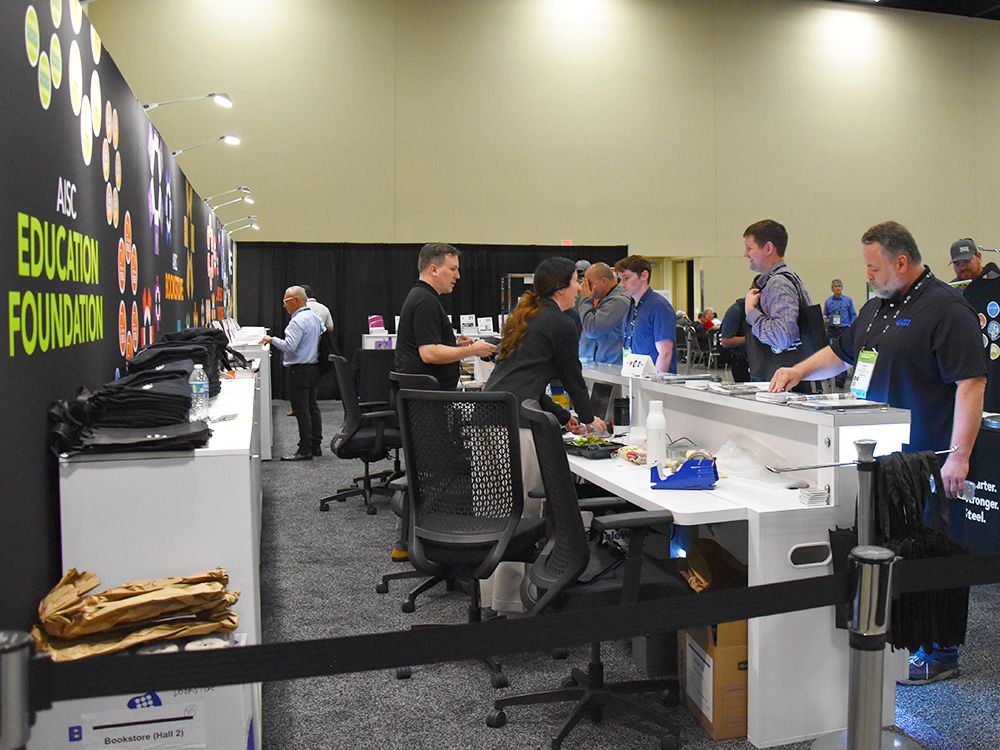2024: A Year for the Books
And we don't just mean the Fourth Edition Seismic Manual.
The American Institute of Steel Construction was up to a lot in 2024, and there is much to be proud of.
With new updates to signature publications, focused initiatives in the areas of workforce development and sustainability, and the creation of a dedicated architect outreach team, AISC has expanded the scope of its impact while maintaining the strength of its core programs.
Read on to learn what made 2024 a memorable year.
Driving Recruitment
Our workforce development programs are introducing waves of new talent to the industry.
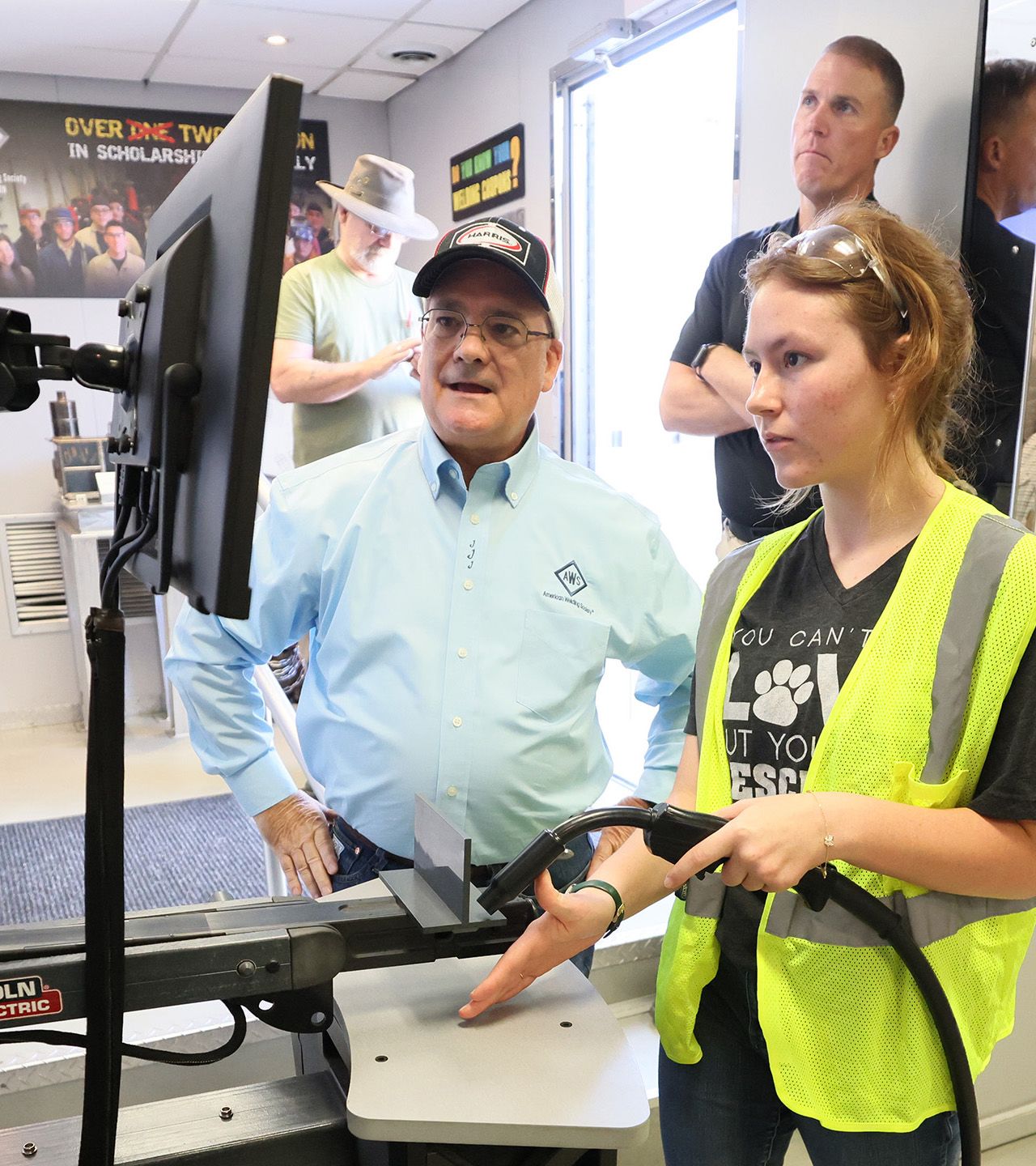

This year, AISC invested in directly tackling the labor shortage with a full-fledged Workforce Development program designed to help companies find—and keep—new talent.
To kick off the program, we launched a lot of new programming at NASCC: The Steel Conference in San Antonio.
- Participants who chose our workforce development conference track walked away with actionable insights into recruiting, hiring, and retaining their future workforce. We kept them busy with 15 sessions specially dedicated to workforce development, and we introduced them to AISC resources that can help them optimize their processes.
- We gave 65 high school welding students an immersive look at what makes the structural steel industry an exciting career path. Through our Forge Your Future program, students got to see the latest technologies (like welding robots!) up close, take part in virtual-reality workshops, and go behind the scenes of steel fabrication.
- AISC partnered with Blue Recruit and Be Pro, Be Proud on the exhibit hall’s Workforce Zone, which brought students and industry professionals together for a variety of competitive, hands-on activities (a lot of these resources are accessible for ongoing use at aisc.org/engage!).
In August, AISC launched its first-ever online Fabricator Education Training Program for full-member companies and their employees.
- In the four months since the launch of 13 "Fabricator Fundamentals" courses, more than 160 fabricators have already opted into the program, with over 1000 courses already completed.
- Even outside of the industry, people have noticed the program! In October, a cohort of peers recognized the Fabricator Education Training Program as the top in its class at DevLearn, the premiere conference for professionals in instructional design, adult learning, and training technologies. FabEd won a “Best in Show” award among 40 competitors and was recognized for its innovative approach, high-quality production, and class-leading instructional design.
This year’s SteelDays celebration reached more than 2,000 high school students, engaging them with the day-to-day operations of a steel fabrication shop and exposing them to various local career opportunities. Fifteen AISC member fabricators opened their shops to Career and Technical Education (CTE) curriculum students, with four fabricators participating for the very first time.
San Antonio Career and Technical Education (CTE) students watch a classmate operate a crane simulator.
San Antonio Career and Technical Education (CTE) students watch a classmate operate a crane simulator.
CTE students get a close-up view of steel cutting at Basden Steel.
CTE students get a close-up view of steel cutting at Basden Steel.
A Texas CTE student tries his hand at tightening a bolt during SteelDays.
A Texas CTE student tries his hand at tightening a bolt during SteelDays.
Engaging Professionals
We create opportunities for fabricators to collaborate and get involved with the wider steel industry.
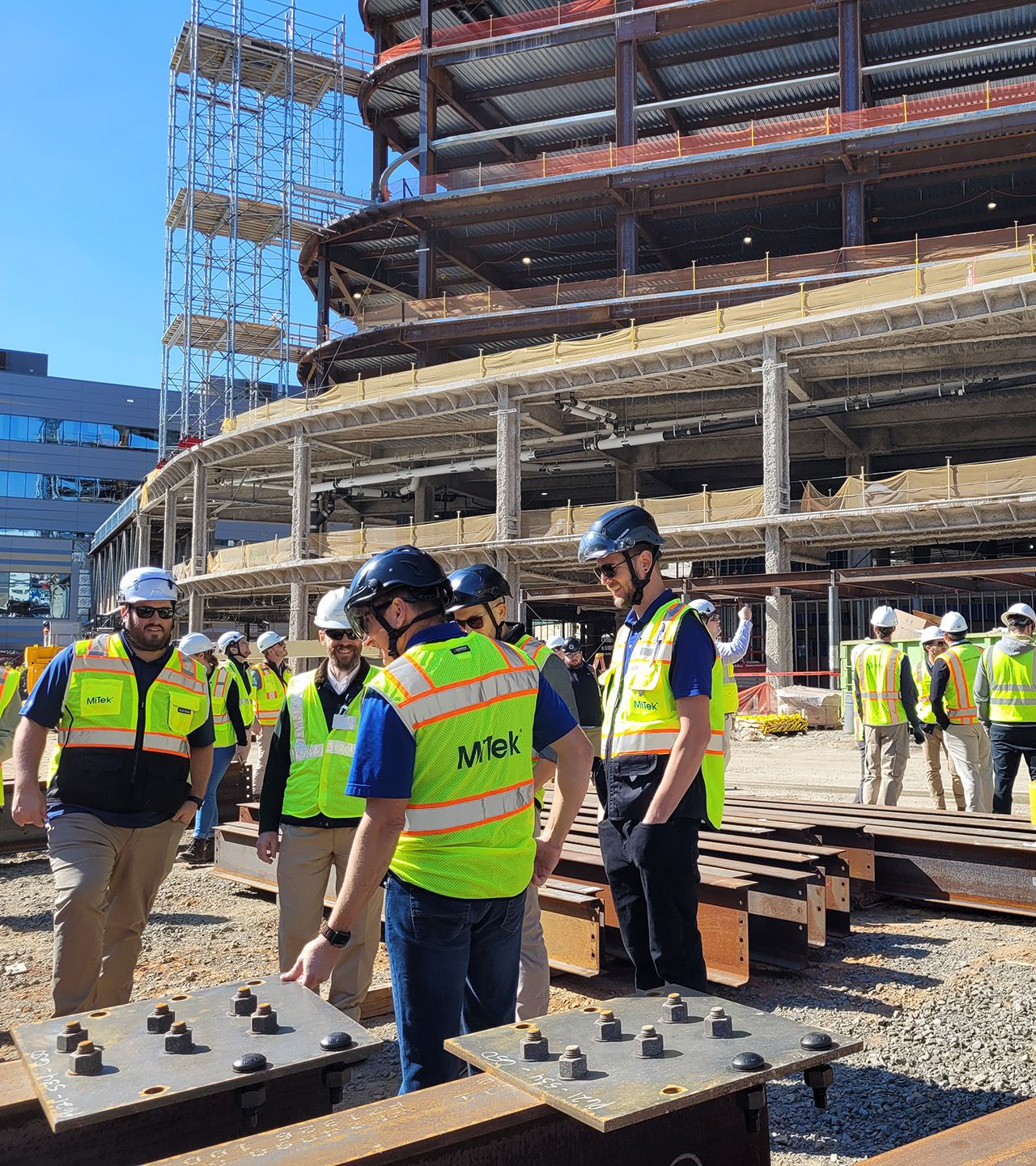

NASCC: The Steel Conference in San Antonio was our largest conference yet. We clocked in at nearly 7,000 attendees, more than 250 technical sessions, a 250,000-sq.-ft exhibit hall, and tons of attendee networking.
- More than 60 young project managers participated in our new Career Accelerator Program with Steel (CAPS), a three-year project management development initiative tailored to engineers, fabricators, and erectors with roughly 5-7 years of experience.
- Video interviews and Newsroom coverage at the Steel Conference unearthed a fascinating story we weren’t telling: People appreciate the sheer diversity of the attendees because they meet and have conversations with people they don’t find at their specific industry conferences. This is a major focus of our 2025 NASCC: The Steel Conference marketing.
NASCC: The Steel Conference participants blow off some steam—and cheer on fellow March Madness fans—at AISC's Pop-A-Shot court.
NASCC: The Steel Conference participants blow off some steam—and cheer on fellow March Madness fans—at AISC's Pop-A-Shot court.
AISC’s Industry Partnership Program expanded its administrative services offerings in 2024 with the addition of the Mid-Atlantic Steel Fabricators Association (MAFSA) & Indiana Fabricators Association (IFA). Our partnership is helping these regional fabricator associations streamline their communications, activities, and member engagement.
AISC hosted our first messaging workshop with MASFA. The session focused on reviewing the key messaging topics, prioritizing "What’s In It For Me" statements, and practicing real-life conversations around them. The session was a great success—we’ve been asked to hold a virtual workshop with sales team members and received follow-up questions about terms like “green steel” and others used in project specifications.
We're celebrating surpassing 1,900 participants in AISC's Quality Certification programs—a nearly 25% increase in the past decade.
AISC launched the Multi-Site Programs for certified participants with multiple facilities or erectors with multiple companies. Participants benefit from reduced audit duration due to eliminating audit overlaps, which saves them time and money.
By the end of 2024, Quality Management Company (QMC) will have performed 1975 audits for current participants in the AISC Certification Program, which resulted in over 2800 audit days. Before year’s end, they will have performed more than 115 initial audits for fabrication facilities and erectors applying to our program.
Meet the people whose lives are changed as a result of a new footbridge constructed by NSBA and industry partners in rural Nyagashanga, Rwanda.
NSBA led a Bridges to Prosperity (B2P) build in Rwanda in May. Ten individuals representing three DOTs, the BNSF Railway, three design consultants, one steel mill, and two fabricators volunteered for the build. Not only is this a way to do charitable good in the world, but it also helps build long-lasting relationships with owners and bridge decision-makers and create buzz within the steel bridge industry.
Engineering & Research facilitated the Safety Awards program and fielded a record number of submissions! We saw a 40% increase in applicants and award recipients compared to 2023.
AISC inaugurated its new Emerging Professionals Panel in October. The goal is to engage early engineering professionals in the structural steel industry and educate them about AISC activities.
AISC Buildings also created a General Contractor program to partner with Associated General Contractors (AGC) chapters as the premier educator for steel information, including Code of Standard Practice (CoSP), Sustainability, and AISC Certification.
Showcasing Sustainability
We are positioning steel as the premier green construction material.
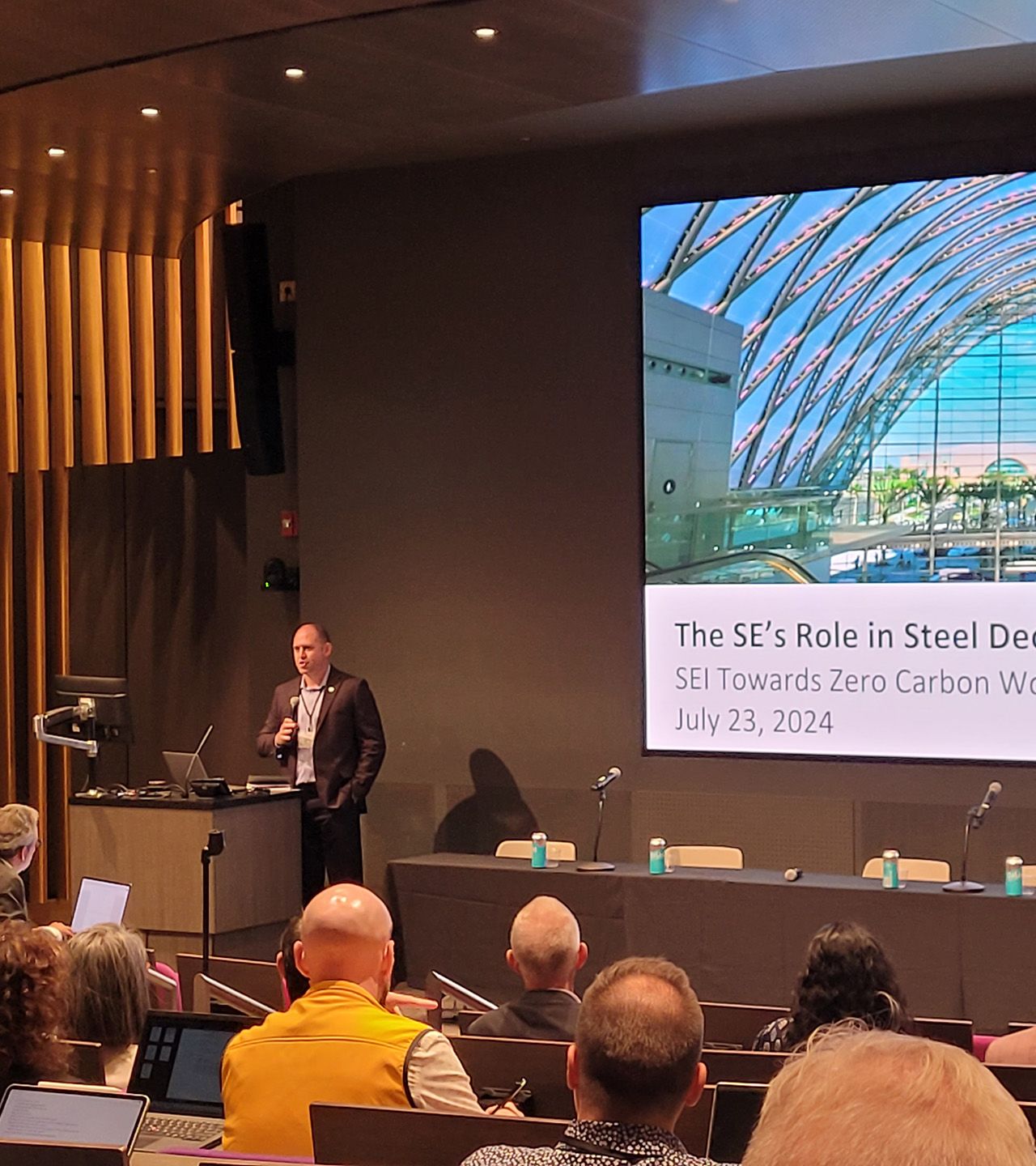

Through first-of-their-kind initiatives and strategic partnerships, AISC has upped the ante in advancing data-driven sustainability and industry-wide transparency in environmental reporting.
AISC, in partnership with the University of Massachusetts Amherst and the American Iron and Steel Institute, received a $6.4 million grant from the U.S. Environmental Protection Agency. This funding will support research into the automation of developing steel product Environmental Product Declarations (EPDs) that provide transparent and standardized information about a product's environmental impact throughout its life cycle. By automating EPD development, AISC aims to streamline the process for steel manufacturers, making it easier to assess and communicate the environmental performance of their products.
The industry increasingly recognizes AISC as the source of information about steel's sustainability. AISC's EPDs webpage added a bottom-line summary of all facility-specific cradle-to-mill-gate global warming potential (GWP) values for domestically produced structural steel in April. Since this addition, the page has already seen a 27% increase in views and a 20% increase in active users compared to the same time period last year.
AISC worked with the Athena Sustainable Materials Institute, a whole building life cycle assessment (LCA) tool provider, to facilitate a better understanding of the steel supply chain. We uncovered some misinterpretations in their embodied carbon calculator that overestimated steel’s job site waste and, in turn, steel’s environmental impact on a construction project. This change will put steel in a more favorable position with respect to embodied carbon on a whole building LCA. We continue to work with other LCA tool providers to ensure they are using the most accurate numbers.
The Steel Manufacturer’s Association (SMA) released a trade agenda policy document for the incoming administration that included AISC’s ask: “Building on its previous policies, the administration should expand the measures to cover certain additional downstream products, including fabricated structural steel and prestressed concrete strand. China and other countries have increasingly pushed steel products into downstream processing industries like fabrication and have been able to avoid the Section 232 measures by doing so.” This milestone reflects our journey to building a strong partnership with SMA that now positions our priorities at the forefront of their agenda, demonstrating the tangible impact of our advocacy and collaboration over the years.
More than 50 fabricators are now participating in AISC’s Sustainability Partner Program, launched this summer to help full member fabricators cut their power bills, reduce emissions, and stand out as competitive choices for specifiers.
Our opposition to Congressional legislation favoring timber has so far been successful. In a joint letter to Congress, AISC, the American Iron and Steel Institute (AISI), and the Steel Manufacturers Association (SMA) outlined their firm opposition to the proposed Mass Timber Federal Buildings Act (S4149)—and urged members of Congress to reject the anti-competitive bill. AISC’s letter was also picked up by national media, including Engineering News Record.
AISC hosted collaborative sustainability workshops in Los Angeles and New York, engaging attendees from across the AEC industry—engineers, architects, steel fabricators, construction managers, and owners. The insights and takeaways from these workshops will feed directly into some of the projects AISC is currently developing, including a sustainability design guide and resource toolkits for designers and owners/developers.
At SEI's "Towards Zero Carbon" workshop, AISC collaborated with designers, contractors, and developers nationwide to advance zero-carbon initiatives in structural engineering.
At SEI's "Towards Zero Carbon" workshop, AISC collaborated with designers, contractors, and developers nationwide to advance zero-carbon initiatives in structural engineering.
At Walter P Moore's Los Angeles office, AEC industry leaders collaborate on a hypothetical project plan that minimizes lifecycle carbon emissions for a building, resulting in the least waste at the end of the building's life.
At Walter P Moore's Los Angeles office, AEC industry leaders collaborate on a hypothetical project plan that minimizes lifecycle carbon emissions for a building, resulting in the least waste at the end of the building's life.
Through collaborative discussion, problem-solving, and presentations from sustainability leaders—including MIT circularity researchers and a presenter from Buro Happold London who spoke on steel reuse case studies in the UK—participants at the New York sustainability workshop explore how structural steel can significantly reduce demolition waste and embodied carbon.
Through collaborative discussion, problem-solving, and presentations from sustainability leaders—including MIT circularity researchers and a presenter from Buro Happold London who spoke on steel reuse case studies in the UK—participants at the New York sustainability workshop explore how structural steel can significantly reduce demolition waste and embodied carbon.
Targeting Architects
We doubled down on our outreach to architects, designers, and other AEC decision-makers.
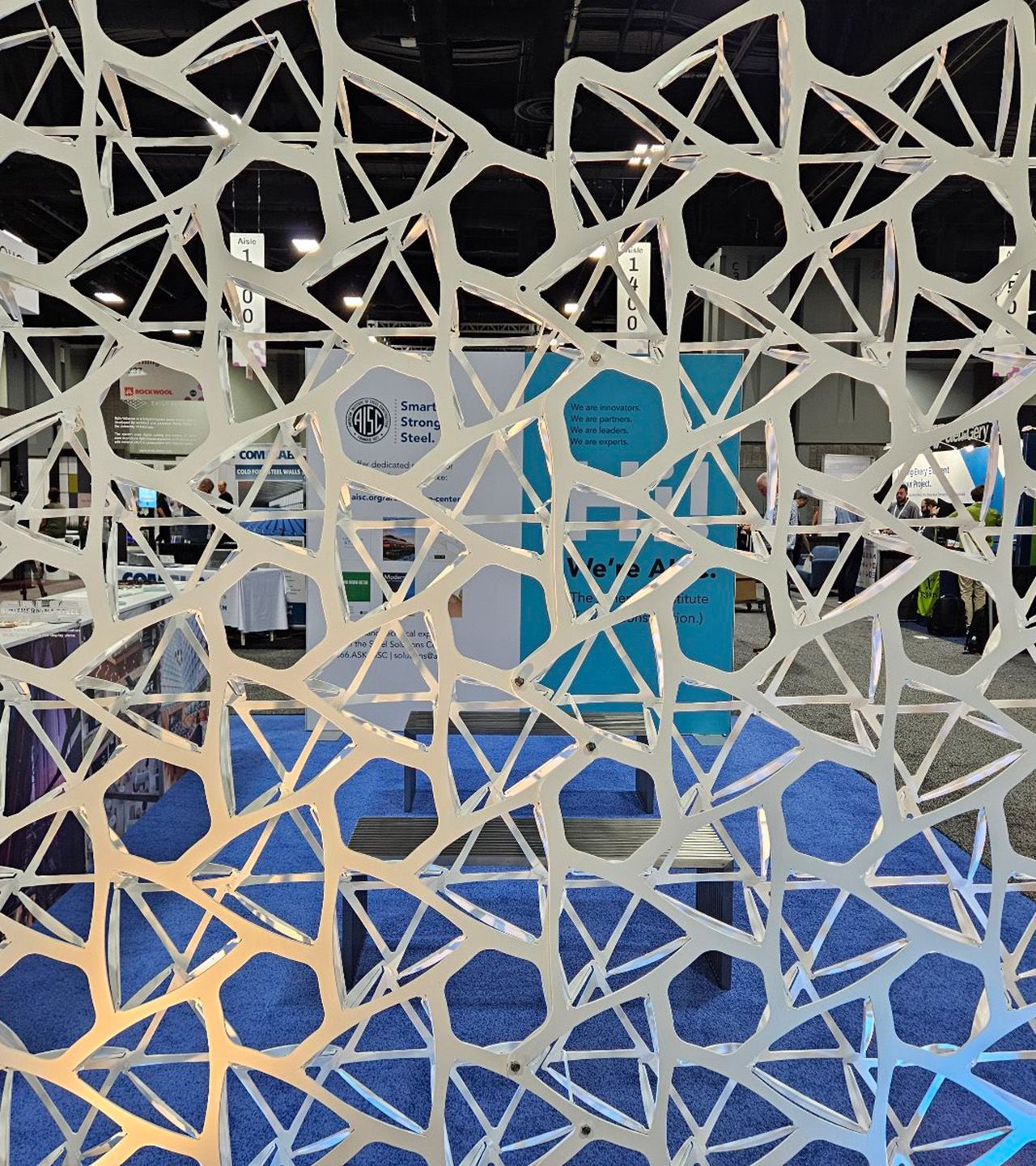

Architects sketch the cityscape at the AISC Architecture Center's urban sketching event.
Architects sketch the cityscape at the AISC Architecture Center's urban sketching event.
The Architecture Center team got to know designers from around the country this year.
The Architecture Center team got to know designers from around the country this year.
Atlanta architects witness steel's sustainability at the Gerdau Cartersville Steel Mill tour.
Atlanta architects witness steel's sustainability at the Gerdau Cartersville Steel Mill tour.
Professionals gather to celebrate steel fabrication at Visions in Steel Philadelphia.
Professionals gather to celebrate steel fabrication at Visions in Steel Philadelphia.
We launched the AISC Architecture Center as a resource hub for architects and created a dedicated website that curates technical information, design guides, case studies, and other resources tailored to their needs.
The Architecture Center made its debut at several major architecture conferences throughout the year.
- At AIA24 in Washington, D.C., the Architecture Center exhibited a steel kirigami wall, a proof-of-concept for the Spin-Valence system used in the 2024 AISC Forge Prize-winning design, Mile Zero. AISC also presented “Elevating Sustainability: The Architect’s Guide to Conscious Material Selection,” focused on educating architects about the environmental benefits of sustainable steel solutions.
- The Architecture Center sponsored two events—the Dine by Design dinner and the urban sketching event—at the AIA Aspire Conference in Asheville, N.C. These events fostered memorable discussions with architects about designing steel structures more effectively.
- AISC presented on topics like SpeedCore, FastFloor, and hybrid designs at the NOMA Conference in Baltimore, introducing architects to innovative steel construction techniques that can transform their designs.
AISC brought architects inside steel mills and fabrication shops with a variety of tours organized by the Architecture Center. Architects learned about sustainable steel manufacturing processes at the Gerdau Cartersville Steel Mill and explored the transformation of architectural designs into fabricated steel components at Barone Steel Fabricators. These tours allowed architects to connect their designs with steel fabrication and construction realities, fostering a deeper understanding of the material's potential.
The Architecture Center hosted several workshops and networking events to provide a space for interaction and knowledge exchange between architects and AISC.
- Architects got hands-on experience with welding at a workshop in partnership with Southern New Jersey Steel.
- AISC also participated in networking events, such as those during DesignPhiladelphia, to connect with architects and build relationships.
Through Visions in Steel exhibits in Philadelphia and Tampa, AISC highlighted the diverse individuals involved in steel fabrication for an audience of architects. The exhibits gave architects a visual representation of the industry's talents and engaged them with the human stories behind steel construction.
Empowering Expertise
AISC remains committed to promoting knowledge sharing among industry professionals, educators, and students.
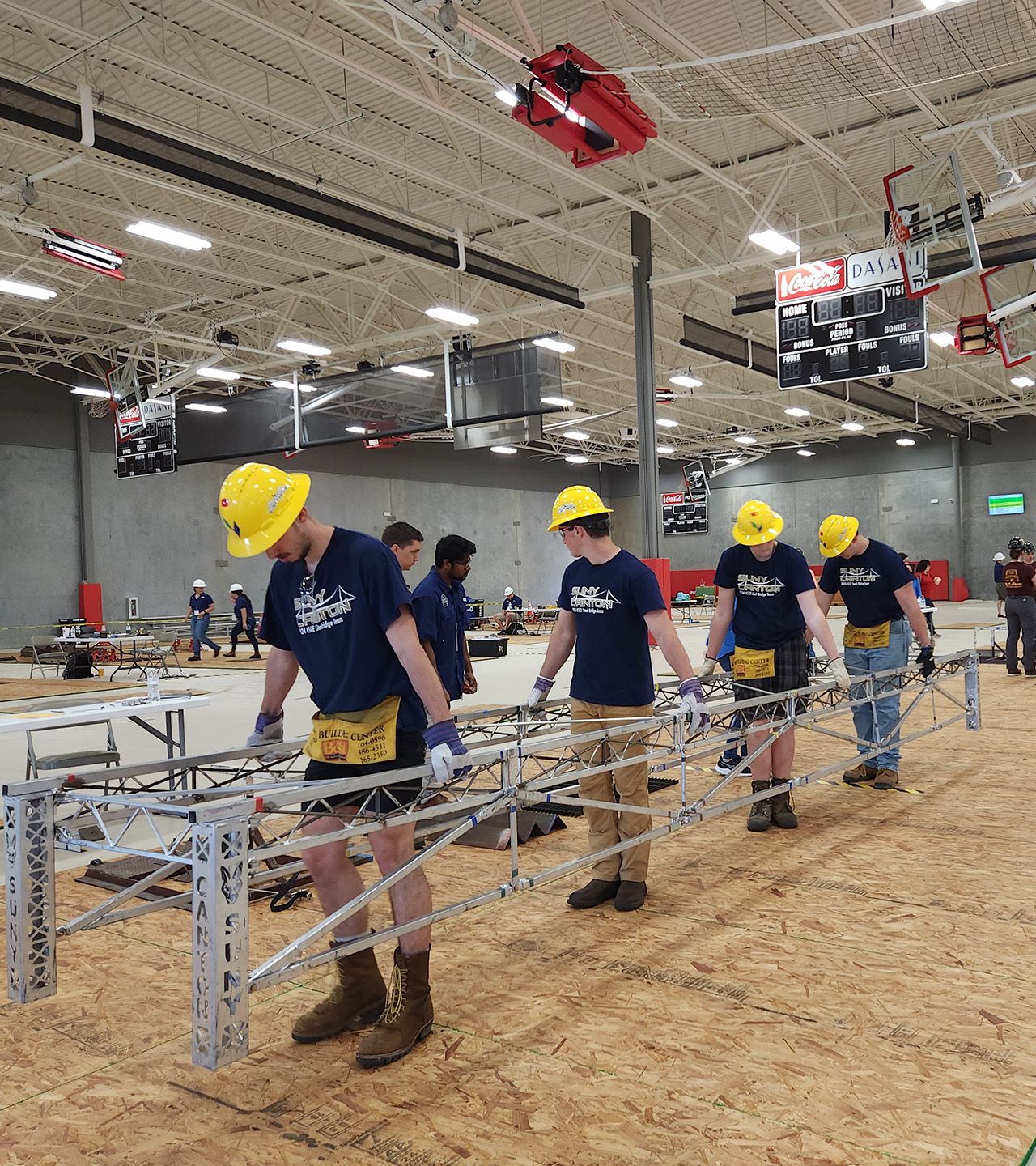

Our main Continuing Education programs—AISC webinars, Night School courses, and the Flash Steel Conference—reached almost 23,000 attendees (9.5% increase over 2023) who earned almost 34,000 PDHs.
Thousands of engineers and designers have fresh insights into technical quandaries and innovative solutions thanks to the Steel Solutions Center staff, who answered around 2,300 questions in 2024.
The first-ever Architecture Educator Workshop gave 24 architecture faculty members valuable resources and connections for teaching steel design courses.
Architecture educators try their hand at designing details that convey specific expressions (including decon and even steampunk!) at the Architecture Educator Workshop.
Architecture educators try their hand at designing details that convey specific expressions (including decon and even steampunk!) at the Architecture Educator Workshop.
Thanks to the newly released Fundamentals of Steel Bridge Engineering course, educators have access to comprehensive resources for teaching steel bridge design and construction.
AISC connected with students in the spirit of innovation and design excellence through several competitions that challenge participants to apply their knowledge and skills in practical ways.
- The 2024 Student Steel Bridge Competition (SSBC), with representatives from 192 schools, pushed students to design, fabricate, and construct steel bridges that meet specific performance requirements.
- The 2024 Steel Design Student Competition for architecture students encouraged architecture students to dream up creative and innovative building designs that use steel.
Delivering Resources
We met members' needs with new and updated technical publications.
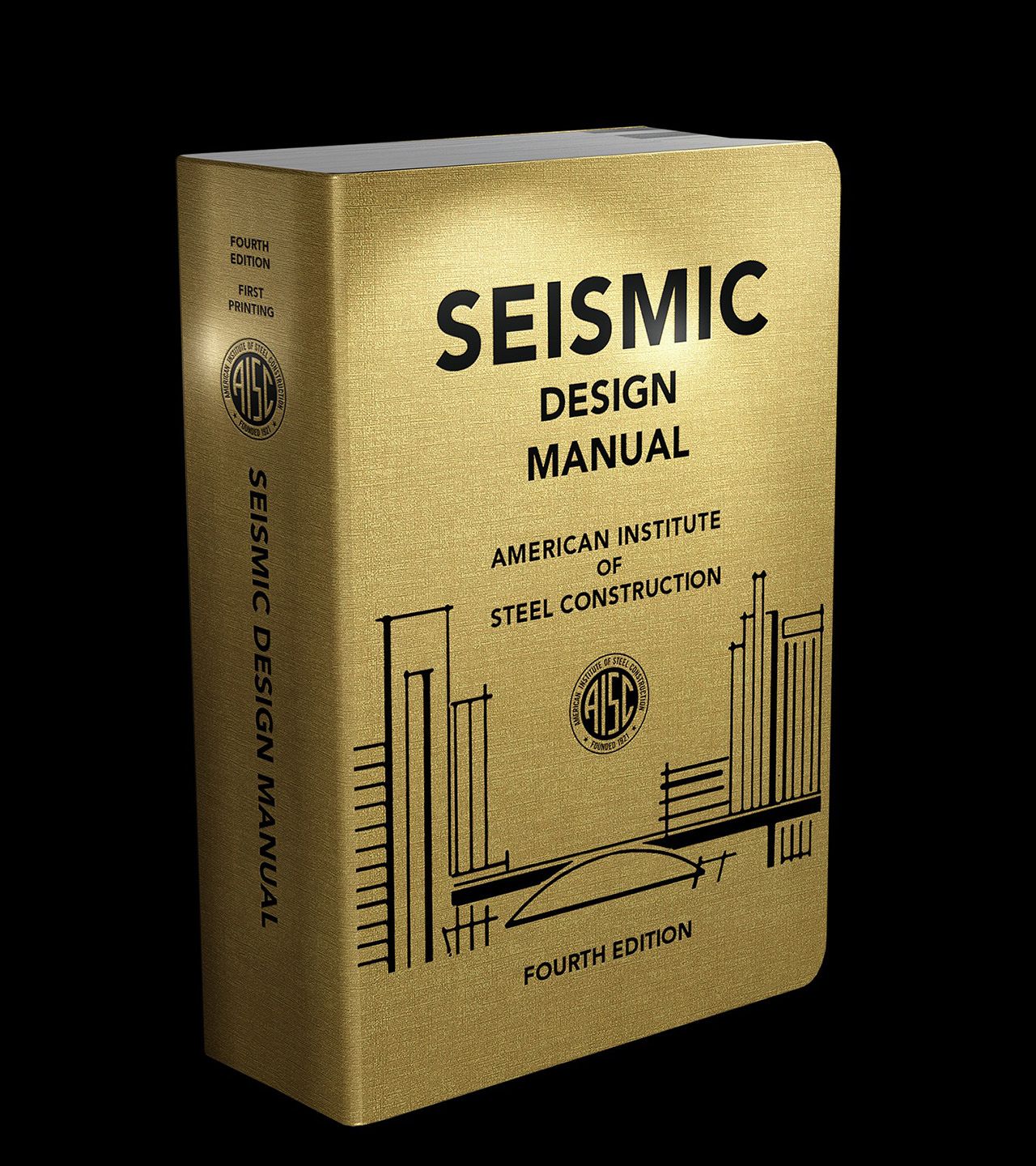

Several flagship AISC publications got a refresh in 2024.
- AISC released the 4th edition of the Seismic Design Manual, with printed copies available by the end of the year.
- The AISC Board of Directors approved the publication of the 2024 edition of AISC N690 Specification for Safety-Related Steel Structures for Nuclear Facilities.
- We published AISC 207-23 Standard for Certification Programs, and AISC Certification implemented it in June.
- Several new editions and publications of AISC design guides went live in 2024, including Design Guide 1: Base Connection Design for Steel Structures, 3rd Ed.; Design Guide 16: Assessment and Repair of Structural Steel in Existing Buildings; Design Guide 24: Hollow Structural Section Connections, 2nd Ed.; and Design Guide 40: Rain Loads and Ponding.
- AISC published the 6th edition of Fire Protection through Modern Building Codes.
- We launched a new digital edition platform for the 16th Edition Steel Construction Manual. The new platform is designed to be faster and easier to use than the previous one and can accommodate additional digital editions in the future.
We partnered with ASTM to create an online subscription that will make it much easier for members to meet their contract requirements—no worrying about outdated documents or confirming the current edition. Best of all, members can access the subscription for half the cost of the non-member rate.
NSBA’s collaboration with the American Association of State Highway and Transportation Officials (AASHTO) Committee on Bridges and Structures (COBS) is going strong. Several new documents have been approved for publication, including Guidelines for the Qualification of Structural Bolting Inspectors (G4.2); Guidelines for Steel Bent Caps (G12.2); and Guidelines for the Analysis of Trusses (G13.2).
Nearly three years ago, NSBA began a collaborative effort with the American Railway Engineering and Maintenance-of-Way Association (AREMA) to develop a much-needed guideline regarding the constructability and fabrication of steel railroad bridges. This volunteer effort between members of AREMA C15 (Steel Structures) and NSBA was completed this year with the publication of the Guidelines for the Design of Steel Railroad Bridges for Constructability and Fabrication.
This year, railroad bridges got an additional boost with NSBA’s newly launched short-span steel railroad bridge prototype, which is designed to position steel as a cost-competitive alternative to prestressed concrete box beams. Railroad professionals and fabricators were able to see the prototype bridge in action at the MxV Rail facility in Pueblo, Colo.!
NSBA updated and re-released the popular NSBA Splice tool in 2024.
In addition to releasing these resources, AISC leveled up its overall customer service:
- We transitioned to a new publications warehouse and fulfillment facility, resulting in faster order fulfillment—within 24 hours!
- With customer satisfaction in mind, AISC sped up response times and issue resolution by moving publications customer service operations in-house.
- Finally, we upgraded our e-commerce system to enable order tracking from multiple shipping carriers.
Supporting Future Innovators
Ensuring a robust American steel industry starts with investing in those who will lead it tomorrow.
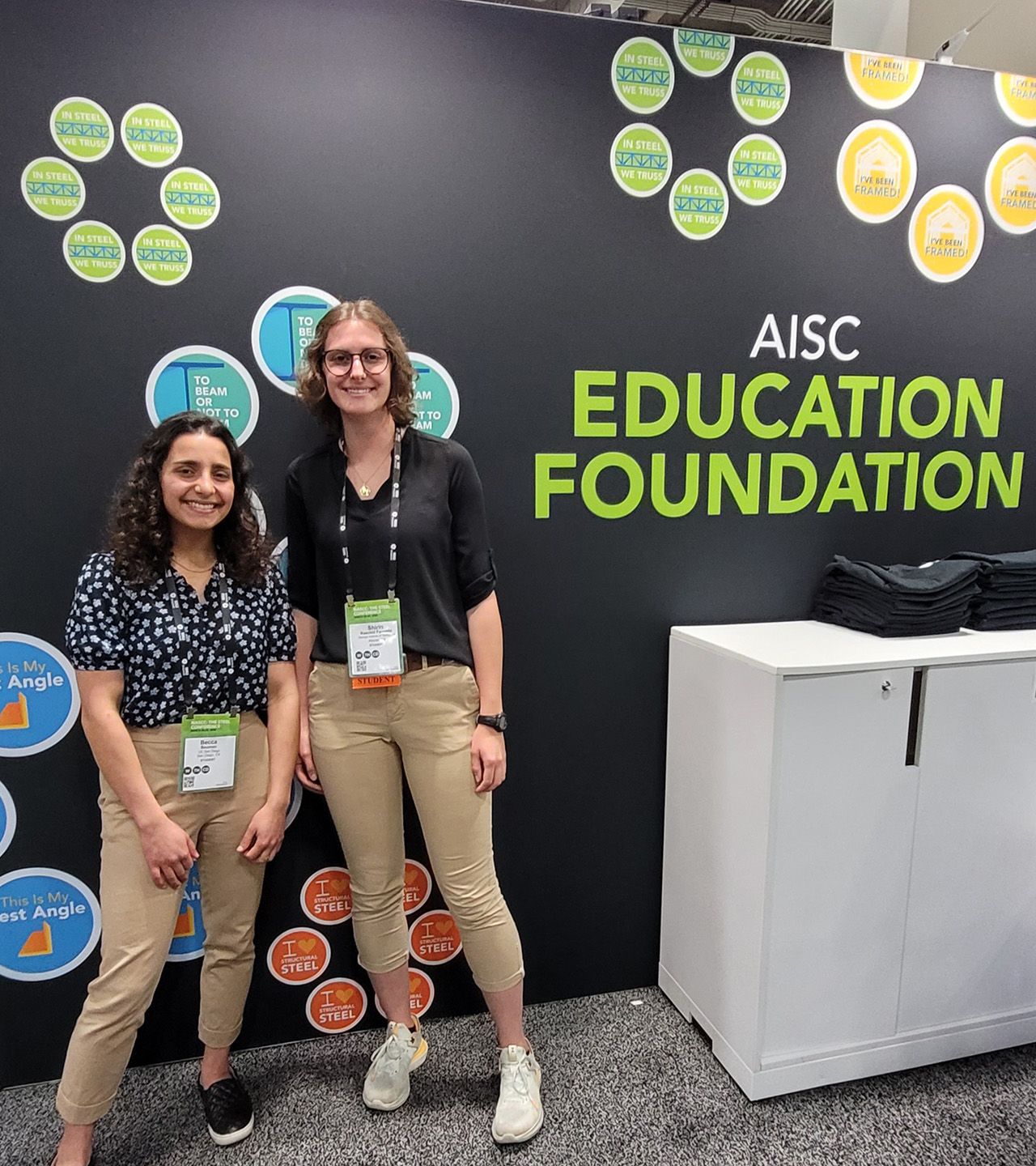

The AISC Education Foundation benefits a lot of people—including today’s college students and the educators encouraging them to dream big; young professionals across the AEC industry preparing to step into leadership roles; and mid-career professionals committed to lifelong learning and research.
The Foundation distributed over $350,000 in scholarships to 107 students and over $100,000 in grants, fellowships, and awards to educators, students, and young professionals.
Mercy Kangogo from Tennessee State University, Robert Bailey Bond from Northeastern University, and Ahmad Hassan of Degenkolb Engineers (the 2024 Reidar Bjorhovde Award recipient) participated in events and sessions at NASCC: The Steel Conference in 2024 thanks to funding from the AISC Education Foundation.
Mercy Kangogo from Tennessee State University, Robert Bailey Bond from Northeastern University, and Ahmad Hassan of Degenkolb Engineers (the 2024 Reidar Bjorhovde Award recipient) participated in events and sessions at NASCC: The Steel Conference in 2024 thanks to funding from the AISC Education Foundation.
Faculty-led field trip grants administered by the Education Foundation brought students to fabrication shops, jobsites, and Iron Worker training facilities, providing them with real-world insights and career-sparking connections.
The Foundation awarded $60,000 toward Design-Build Grant Program proposals submitted by university architecture programs.
Stan Carroll of Beyond Metal presents "Reviving the Master Builder Mindset" to architecture students at Rice University. This presentation was possible thanks to an AISC Education Foundation Campus Connection Grant.
Stan Carroll of Beyond Metal presents "Reviving the Master Builder Mindset" to architecture students at Rice University. This presentation was possible thanks to an AISC Education Foundation Campus Connection Grant.
University faculty and AISC Student Clubs hosted steel-focused speaking engagements on their campuses through Campus Connection Grants.
AISC Director of Foundation Programs Maria Mnookin (left) and Vice President of Engineering and Research Chris Raebel (right) are part of the team that hosted AISC's inaugural Innovation Scholars, Ashley Thrall (second from the left) and Joshua Schultz (third from the left), for two weeks of industry engagement and research in the Chicago headquarters.
AISC Director of Foundation Programs Maria Mnookin (left) and Vice President of Engineering and Research Chris Raebel (right) are part of the team that hosted AISC's inaugural Innovation Scholars, Ashley Thrall (second from the left) and Joshua Schultz (third from the left), for two weeks of industry engagement and research in the Chicago headquarters.
AISC’s inaugural Innovation Scholars, Joshua Schultz, PE, PhD of Gonzaga University, and Ashley Thrall, PhD of the University of Notre Dame, spent two weeks immersed in research and industry engagement at AISC’s Chicago headquarters.
- Schultz focused on developing simplified design tools for complex steel applications to assist engineers in early design decisions.
- Thrall examined how bridge designers can harness the advantages of modularity and structural redundancy while also minimizing material usage.
NASCC: The Steel Conference participants browse and purchase manuals and AISC merchandise at the conference's very first Education Foundation bookstore.
NASCC: The Steel Conference participants browse and purchase manuals and AISC merchandise at the conference's very first Education Foundation bookstore.
The Education Foundation teamed up with the publications department to create AISC’s first-ever swag store at NASCC: The Steel Conference, with all proceeds designated for the Education Foundation. Pre-registration donations and sales proceeds surpassed $12,000!
Everything AISC does is intended to increase the use of domestic fabricated structural steel, and we couldn't do it without our members.
AISC's membership represents more than 36,000 individual designers and educators, and more than 1,500 fabricators, mills, service centers, erectors, detailers, and product suppliers.
©2025 American Institute of Steel Construction. All Rights Reserved. Terms & Conditions


